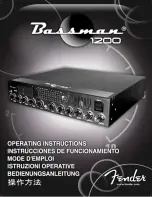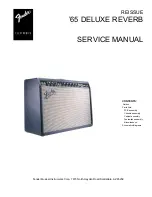
Macro-Tech 3600VZ Power Amplifier
Page 11
Reference Manual
3 Installation
3.1 Mounting
Macro-Tech amplifiers are designed for standard 19
inch (48.3 cm) rack mounting and “stack” mounting
without a cabinet. In a rack cabinet, it is best to mount
them one on top of the other. This provides efficient air
flow and enables each unit to support the one above.
Important:
Due to its weight, the back of the amplifier
should be supported.
Fig. 3.2 Top View of a Rack-Mounted Unit
If the air supply is unusually dusty, it may be necessary
pre-filter it using commercial furnace filters, etc., to pre-
vent rapid loading of the unit’s own air filter. When
needed, the unit’s filter can be cleaned with mild dish
detergent and water (see Section 4.5).
When mounting the amplifier in a rack cabinet, the side
walls of the rack should be at least 2 inches (5 cm) away
from the chassis as shown in Figure 3.2.
Tip:
An easy way to verify adequate cooling is to ob-
serve the ODEP indicators with the amplifier operating
under worst-case conditions. If the indicators dim, ad-
ditional cooling is recommended.
If your rack cabinet has a front door that could block air
flow to the amplifier’s air intakes, you must provide ad-
equate air flow either with a grille in the door or by pres-
surizing the air behind the door. Wire grilles are
recommended over perforated panels because they
have larger openings and cause less restriction.
A good choice for increased air flow behind a rack cabi-
net door is to mount one or more “squirrel cage” blow-
ers in the rack (Option 1 below). The blower is mounted
at the bottom of the rack so it blows outside air into the
space between the door and the front of the amplifiers.
This blower should not blow air into or take air out of the
space behind the amplifiers. For racks without a door,
mount a blower at the top of the rack so air is drawn out
the back (Option 2 below). The blower must provide air
flow that exceeds the sum of the air flow required by the
individual amplifiers.
Fig. 3.3 Proper Air Flow in a Rack Cabinet
Fig. 3.1 Mounting Dimensions
3.2 Cooling
NEVER block the amplifier’s side vents and front air in-
take. Under demanding conditions, there should be a
minimum air flow of 45 cubic feet (1.3 cubic meters) per
minute per amplifier. When mounted in a rack, all empty
spaces should be covered with blank panels to prevent
improper air flow. The amplifier’s air flow should be aug-
mented with a rack cooling system if its load is less than
4 ohms and it must operate at consistently high output
levels as in concert sound reinforcement.
AIR
FLOW
AIR FLOW
AMPLIFIER
(TOP VIEW)
RACK
CABINET
16 in
40.6 cm
2 in
(5 cm)
MIN.
IMPORTANT: Be sure rear of amplifier
is securely mounted to rack.
17 in
43.2 cm
AIR
FLOW
BLOWER
(OPTION 2)
BLOWER
(OPTION 1)
AIR
FLOW
FRONT
OF
RACK
DOOR
AIR
FLOW
EQUIPMENT
RACK
(SIDE VIEW)












































